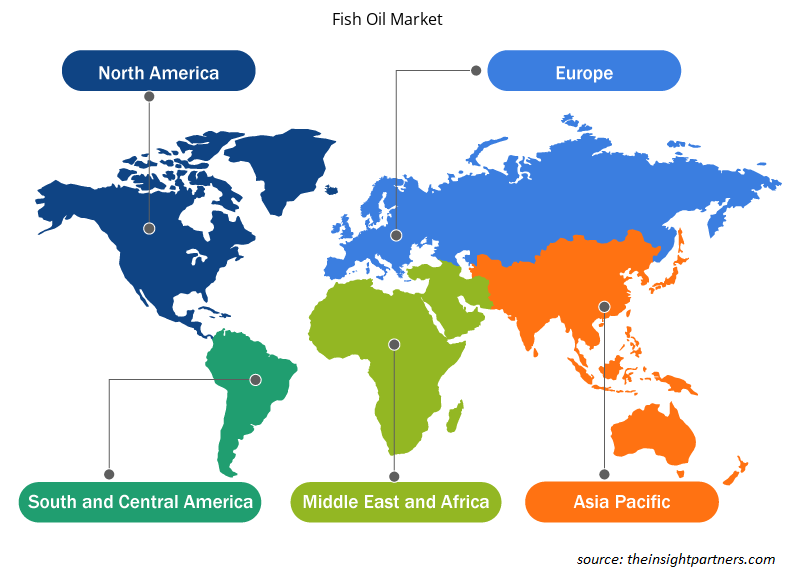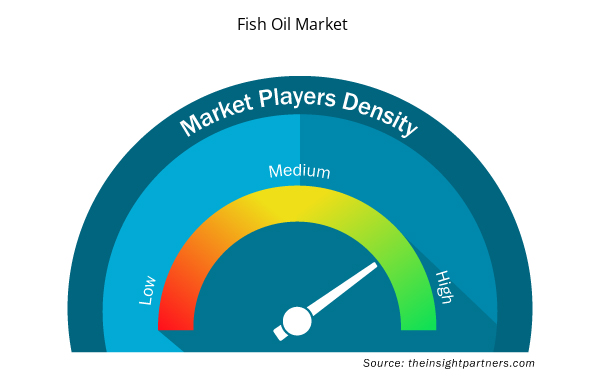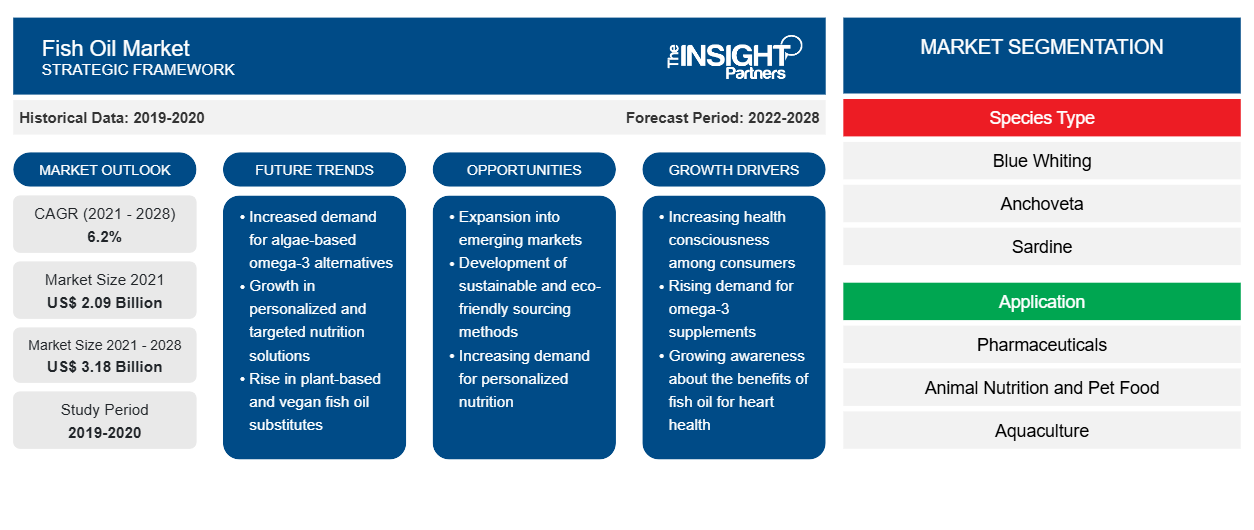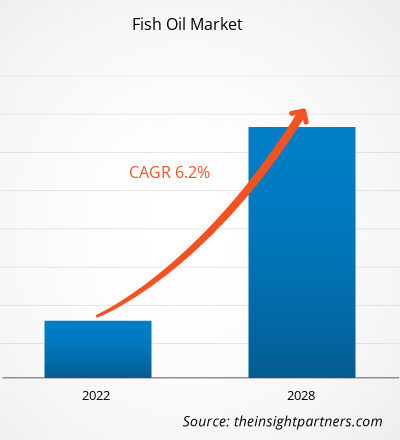2021 年鱼油市场价值为 20.8739 亿美元,预计到 2028 年将达到 31.7828 亿美元。预计 2021 年至 2028 年的复合年增长率为 6.2%。
鱼油取自各种鱼类的组织,含有 omega-3 脂肪酸,例如二十碳五烯酸 (EPA) 和二十二碳六烯酸 (DHA)。它们具有多种健康益处,包括降低心脏病发作导致的死亡风险、危险的心律失常、降低甘油三酯和中风。
2020 年,亚太地区在全球鱼油市场占据主导地位,预计在预测期内仍将保持主导地位。人们对鱼油健康益处和丰富营养成分的认识不断提高,推动了该地区鱼油市场的增长。与此同时,该地区各国慢性病患病率的上升也导致对鱼油的需求增加。例如,在澳大利亚,据估计,50% 的澳大利亚人至少患有 8 种常见慢性疾病中的 1 种:癌症、心血管疾病、精神健康状况、关节炎、背痛和问题、慢性阻塞性肺病、哮喘和糖尿病。这些因素预计将促进该地区对鱼油的需求增长。
定制此报告以满足您的需求
您可以免费定制任何报告,包括本报告的部分内容、国家级分析、Excel 数据包,以及为初创企业和大学提供优惠和折扣
- 获取此报告的关键市场趋势。这个免费样品将包括数据分析,从市场趋势到估计和预测。
市场洞察
鱼油在不同行业中的广泛应用
鱼油在制药、膳食补充剂、动物营养和宠物食品等各个行业中的应用越来越广泛。它在制药领域有着广泛的应用,被认为是天然油或 EPA-DHA 浓缩物。它还用于动物饲料,因为它具有促进生长的作用,是一种廉价的能量来源。除此之外,它还用于宠物食品,有助于增强狗的免疫系统,同时还有助于对抗犬癌症。鱼油也被用作膳食补充剂,其胶囊传统上是用明胶制成的,明胶覆盖软胶囊中的油。因此,鱼油在不同行业的使用推动了鱼油市场的增长。
物种类型洞察
根据鱼种类型,鱼油市场分为蓝鳕鱼、凤尾鱼、沙丁鱼、毛鳞鱼等。2020 年,沙丁鱼细分市场是市场上增长最快的细分市场。沙丁鱼是一种体型较小的鲱鱼类鱼类,具有与鲑鱼等其他鱼类类似的多种营养价值。从沙丁鱼中提取的油也可用作润滑剂,主要用于油漆、清漆、生物燃料和油毡。
Pesquera Exalmar SAA;Omega Protein Corporation;Pelagia AS;Copeinca;Coplex International SAC;Triplenine;FF Skagen A/S;DSM;Croda International PLC;和 BASF SE 是鱼油市场的主要参与者。领先的参与者采用多种策略,例如并购和产品发布,以扩大其地理覆盖范围和消费者基础。
报告亮点
- 鱼油行业的进步趋势有助于参与者制定有效的长期战略
- 公司采用的业务增长战略来确保发达市场和发展中市场的增长
- 2019 年至 2028 年全球鱼油市场定量分析
- 各行业对鱼油的需求估计
- 波特的分析说明了行业内买家和供应商预测市场增长的有效性
- 了解竞争激烈的市场形势和对鱼油的需求的最新发展
- 市场趋势和前景以及推动和抑制鱼油市场增长的因素
- 了解全球鱼油市场增长的商业利益战略,有助于决策过程
- 鱼油市场各节点规模
- 全球鱼油市场的详细概述和细分以及其行业动态
- 各地区鱼油市场规模及增长潜力巨大
鱼油市场区域洞察
Insight Partners 的分析师详细解释了预测期内影响鱼油市场的区域趋势和因素。本节还讨论了北美、欧洲、亚太地区、中东和非洲以及南美和中美洲的鱼油市场细分和地理位置。

- 获取鱼油市场的区域特定数据
鱼油市场报告范围
| 报告属性 | 细节 |
|---|---|
| 2021 年市场规模 | 20.9亿美元 |
| 2028 年市场规模 | 31.8亿美元 |
| 全球复合年增长率(2021 - 2028) | 6.2% |
| 史料 | 2019-2020 |
| 预测期 | 2022-2028 |
| 涵盖的领域 | 按物种类型
|
| 覆盖地区和国家 | 北美
|
| 市场领导者和主要公司简介 |
|
鱼油市场参与者密度:了解其对业务动态的影响
鱼油市场正在快速增长,这得益于终端用户需求的不断增长,这些需求源于消费者偏好的不断变化、技术进步以及对产品益处的认识不断提高等因素。随着需求的增加,企业正在扩大其产品范围,进行创新以满足消费者的需求,并利用新兴趋势,从而进一步推动市场增长。
市场参与者密度是指在特定市场或行业内运营的企业或公司的分布情况。它表明相对于给定市场空间的规模或总市场价值,有多少竞争对手(市场参与者)存在于该市场空间中。
在鱼油市场运营的主要公司有:
- 埃克萨马尔渔业公司
- 欧米茄蛋白质公司
- 佩拉吉亚
- 科佩因卡
- 科普莱克斯国际有限公司
免责声明:上面列出的公司没有按照任何特定顺序排列。

- 获取鱼油市场顶级关键参与者概述
“2028 年全球鱼油市场分析”是一项针对食品和饮料行业的专业深入研究,特别关注全球鱼油市场的趋势分析。该报告旨在提供市场概述和详细的市场细分。鱼油市场从三个方面进行分析:物种类型、应用和地理。根据物种类型,市场分为蓝鳕鱼、凤尾鱼、沙丁鱼、毛鳞鱼等。根据应用,鱼油市场分为药品、动物营养和宠物食品、水产养殖、膳食补充剂等。根据地理位置,鱼油市场分为五个主要地区——北美、欧洲、亚太地区、中东和非洲以及南美和中美洲。
公司简介
- 巴斯夫
- 科佩因卡
- 复合国际SAC
- 禾大国际有限公司
- 帝斯曼
- FF 斯卡恩公司
- Omega 蛋白质公司
- 佩拉吉亚
- 佩斯克拉埃克斯阿尔玛 SAA
- 三联苯胺
- 历史分析(2 年)、基准年、预测(7 年)及复合年增长率
- PEST 和 SWOT 分析
- 市场规模价值/数量 - 全球、区域、国家
- 行业和竞争格局
- Excel 数据集


- Sports Technology Market
- Europe Tortilla Market
- Pharmacovigilance and Drug Safety Software Market
- Semiconductor Metrology and Inspection Market
- Long Read Sequencing Market
- Small Satellite Market
- Bioremediation Technology and Services Market
- Europe Surety Market
- Machine Condition Monitoring Market
- Ketogenic Diet Market

Report Coverage
Revenue forecast, Company Analysis, Industry landscape, Growth factors, and Trends

Segment Covered
This text is related
to segments covered.

Regional Scope
North America, Europe, Asia Pacific, Middle East & Africa, South & Central America

Country Scope
This text is related
to country scope.
常见问题
Based on species type, the sardine segment was the fastest-growing segment in the market. Sardine is a small, herring-like fish with various nutritional benefits similar to other species such as salmon. The oil extracted from sardine is also used as a lubricant and is mostly used in paints, varnishes, biofuels, and linoleum.
In 2020, the blue whiting segment accounted for the largest fish oil market share, based on species type. Blue whiting is one of the cod family species and one of the most abundant fish stocks in the semi-pelagic water masses of the Northeast Atlantic. The fish oil derived from blue whiting is a potential source of omega-3 fatty acids.
The market for the pharmaceuticals segment is expected to grow at a faster pace during the forecast period. In various countries, such as Japan, the consumption of nutritional and pharmaceutical-grade fish oil is significantly increasing due to the surge in the presence of the geriatric population, which is likely to result in the rise in demand for pharmaceutical-grade fish oil for various health benefits.
Fish oil is associated with various health benefits and helps in reducing the risk of cardiovascular diseases, lowers blood pressure, and slows the buildup of atherosclerotic plaques. Fish oil is also considered one of the valuable nutrients for both humans and livestock. Fish liver oil and fish body oil are the two types of fish oil. Fish oil is a rich source of Omega-3 fatty acids and includes the presence of vitamins and minerals, such as vitamin A and vitamin D, which are essential for the human body. In addition, the DHA present in fish oil improves memory and cognitive function and plays an important role in the development of an infant's brain. Thus, such health benefits are increasing the demand for fish oil across the world.
The major key players operating in the global fish oil market include Pesquera Exalmar S.A.A.; Omega Protein Corporation; Pelagia AS; Copeinca; Coplex International S.A.C; Triplenine; FF Skagen A/S; DSM; Croda International PLC; and BASF SE.
In 2020, Asia Pacific dominated the global fish oil market. The region is expected to continue its dominance during the forecast period. Trends in this market are influenced by the increasing awareness about the health benefits of omega-3, present abundantly in fish oil. Omega-3 fatty acids are beneficial for the geriatric population as it helps in reducing the risk of chronic diseases and provide preventive measures in terms of heart, cognitive, eye, and joint deterioration.
Trends and growth analysis reports related to Consumer Goods : READ MORE..
The List of Companies - Global Fish Oil Market
- PESQUERA EXALMAR S.A.A.
- OMEGA PROTEIN CORPORATION
- PELAGIA AS
- COPEINCA
- COPLEX INTERNATIONAL S.A.C
- TRIPLENINE
- FF SKAGEN A/S
- DSM
- CRODA INTERNATIONAL PLC
- BASF SE
The Insight Partners performs research in 4 major stages: Data Collection & Secondary Research, Primary Research, Data Analysis and Data Triangulation & Final Review.
- Data Collection and Secondary Research:
As a market research and consulting firm operating from a decade, we have published and advised several client across the globe. First step for any study will start with an assessment of currently available data and insights from existing reports. Further, historical and current market information is collected from Investor Presentations, Annual Reports, SEC Filings, etc., and other information related to company’s performance and market positioning are gathered from Paid Databases (Factiva, Hoovers, and Reuters) and various other publications available in public domain.
Several associations trade associates, technical forums, institutes, societies and organization are accessed to gain technical as well as market related insights through their publications such as research papers, blogs and press releases related to the studies are referred to get cues about the market. Further, white papers, journals, magazines, and other news articles published in last 3 years are scrutinized and analyzed to understand the current market trends.
- Primary Research:
The primarily interview analysis comprise of data obtained from industry participants interview and answers to survey questions gathered by in-house primary team.
For primary research, interviews are conducted with industry experts/CEOs/Marketing Managers/VPs/Subject Matter Experts from both demand and supply side to get a 360-degree view of the market. The primary team conducts several interviews based on the complexity of the markets to understand the various market trends and dynamics which makes research more credible and precise.
A typical research interview fulfils the following functions:
- Provides first-hand information on the market size, market trends, growth trends, competitive landscape, and outlook
- Validates and strengthens in-house secondary research findings
- Develops the analysis team’s expertise and market understanding
Primary research involves email interactions and telephone interviews for each market, category, segment, and sub-segment across geographies. The participants who typically take part in such a process include, but are not limited to:
- Industry participants: VPs, business development managers, market intelligence managers and national sales managers
- Outside experts: Valuation experts, research analysts and key opinion leaders specializing in the electronics and semiconductor industry.
Below is the breakup of our primary respondents by company, designation, and region:

Once we receive the confirmation from primary research sources or primary respondents, we finalize the base year market estimation and forecast the data as per the macroeconomic and microeconomic factors assessed during data collection.
- Data Analysis:
Once data is validated through both secondary as well as primary respondents, we finalize the market estimations by hypothesis formulation and factor analysis at regional and country level.
- Macro-Economic Factor Analysis:
We analyse macroeconomic indicators such the gross domestic product (GDP), increase in the demand for goods and services across industries, technological advancement, regional economic growth, governmental policies, the influence of COVID-19, PEST analysis, and other aspects. This analysis aids in setting benchmarks for various nations/regions and approximating market splits. Additionally, the general trend of the aforementioned components aid in determining the market's development possibilities.
- Country Level Data:
Various factors that are especially aligned to the country are taken into account to determine the market size for a certain area and country, including the presence of vendors, such as headquarters and offices, the country's GDP, demand patterns, and industry growth. To comprehend the market dynamics for the nation, a number of growth variables, inhibitors, application areas, and current market trends are researched. The aforementioned elements aid in determining the country's overall market's growth potential.
- Company Profile:
The “Table of Contents” is formulated by listing and analyzing more than 25 - 30 companies operating in the market ecosystem across geographies. However, we profile only 10 companies as a standard practice in our syndicate reports. These 10 companies comprise leading, emerging, and regional players. Nonetheless, our analysis is not restricted to the 10 listed companies, we also analyze other companies present in the market to develop a holistic view and understand the prevailing trends. The “Company Profiles” section in the report covers key facts, business description, products & services, financial information, SWOT analysis, and key developments. The financial information presented is extracted from the annual reports and official documents of the publicly listed companies. Upon collecting the information for the sections of respective companies, we verify them via various primary sources and then compile the data in respective company profiles. The company level information helps us in deriving the base number as well as in forecasting the market size.
- Developing Base Number:
Aggregation of sales statistics (2020-2022) and macro-economic factor, and other secondary and primary research insights are utilized to arrive at base number and related market shares for 2022. The data gaps are identified in this step and relevant market data is analyzed, collected from paid primary interviews or databases. On finalizing the base year market size, forecasts are developed on the basis of macro-economic, industry and market growth factors and company level analysis.
- Data Triangulation and Final Review:
The market findings and base year market size calculations are validated from supply as well as demand side. Demand side validations are based on macro-economic factor analysis and benchmarks for respective regions and countries. In case of supply side validations, revenues of major companies are estimated (in case not available) based on industry benchmark, approximate number of employees, product portfolio, and primary interviews revenues are gathered. Further revenue from target product/service segment is assessed to avoid overshooting of market statistics. In case of heavy deviations between supply and demand side values, all thes steps are repeated to achieve synchronization.
We follow an iterative model, wherein we share our research findings with Subject Matter Experts (SME’s) and Key Opinion Leaders (KOLs) until consensus view of the market is not formulated – this model negates any drastic deviation in the opinions of experts. Only validated and universally acceptable research findings are quoted in our reports.
We have important check points that we use to validate our research findings – which we call – data triangulation, where we validate the information, we generate from secondary sources with primary interviews and then we re-validate with our internal data bases and Subject matter experts. This comprehensive model enables us to deliver high quality, reliable data in shortest possible time.


 获取此报告的免费样本
获取此报告的免费样本